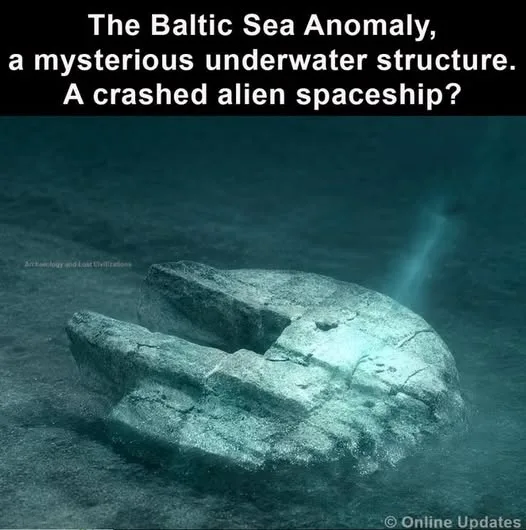In the vast expanse of our oceans, there are always whispers of the unknown, intriguing anomalies that spark our curiosity and ignite our imaginations. One such enigma that captured the world’s attention is the so-called “Baltic Sea Anomaly.” Discovered in the depths of the Baltic Sea in 2011, this peculiar underwater structure fueled speculation ranging from sunken alien spacecraft to lost ancient civilizations. Let’s dive into the story of this deep-sea mystery and see what light has been shed on its true nature.

It was in June of 2011 that a Swedish ocean exploration team, the aptly named Ocean X Team, while searching for shipwrecks, detected a large, circular object resting on the seabed. Located at a depth of approximately 85 meters (280 feet), this anomaly measured roughly 60 meters (200 feet) in diameter. Sonar images revealed a somewhat disc-shaped object with unusual features and what appeared to be drag marks or a trail leading away from it.
Immediately, the internet buzzed with theories. The distinct, almost geometric shape, combined with the mysterious trail, conjured up visions of crashed UFOs, remnants of secret military projects, or even the remnants of a long-lost, technologically advanced underwater civilization. The image you often see associated with the anomaly, often enhanced with glowing effects, certainly adds to this air of intrigue.
However, as is often the case with such captivating mysteries, the more scientific scrutiny applied, the more terrestrial explanations began to emerge. While the Ocean X Team initially kept an open mind, collecting samples and conducting further dives, the broader scientific community approached the findings with a healthy dose of skepticism.
The Verdict (So Far): Nature’s Hand at Work
Over time, the prevailing scientific consensus has leaned heavily towards a natural geological formation. Geologists and marine scientists who have examined the sonar data and the samples retrieved from the site suggest that the “anomaly” is most likely a large glacial erratic.
Glacial erratics are boulders or rocks that were transported by glaciers during past ice ages and deposited in areas far from their original source. As massive ice sheets moved across the landscape, they picked up rocks of all sizes. When the glaciers retreated, these rocks were left behind, often in locations where they seemed out of place.
In the case of the Baltic Sea Anomaly, it’s theorized that this large rock formation could have been shaped by glacial movement and subsequent erosion over thousands of years. The “trail” observed in the sonar images is also likely a natural feature of the seabed, perhaps a groove created by the movement of the glacier or the deposition of sediment.
Some researchers have even suggested the possibility of it being a rock outcrop of volcanic origin, further shaped by the relentless forces of nature and the unique conditions of the Baltic Sea floor.
Why the Initial Fascination?
Despite the leaning towards a natural explanation, the initial allure of the Baltic Sea Anomaly is understandable. The human mind is naturally drawn to the unknown, and the idea of a mysterious object lying silently on the ocean floor sparks a sense of wonder. The sometimes unclear nature of sonar images can also leave room for interpretation, fueling imaginative theories.
The Ongoing Dialogue:
It’s important to note that while the dominant scientific view points to a natural formation, the Ocean X Team and some enthusiasts still maintain a degree of open-mindedness, citing certain aspects of the object’s composition and shape that they find unusual. However, without more extensive and independent scientific investigation, the prevailing theory of a geological origin remains the most plausible.
A Reminder of Earth’s Own Mysteries:
The story of the Baltic Sea Anomaly serves as a fascinating reminder that our own planet still holds countless mysteries, even in the depths of our oceans. While the idea of a submerged alien spacecraft is certainly captivating, the likely reality of a unique geological formation is no less remarkable. It highlights the powerful forces of nature that can sculpt and shape our world in ways that sometimes seem almost artificial.
So, while the dream of uncovering extraterrestrial relics in the Baltic Sea may have to wait, the tale of this underwater anomaly remains a compelling example of how scientific exploration, coupled with critical thinking, helps us unravel the enigmas of our planet. And who knows what other natural wonders lie waiting to be discovered in the vast, unexplored territories beneath the waves?





